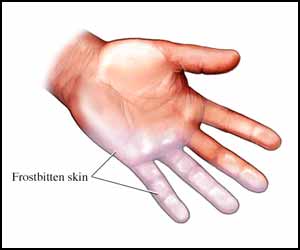- Home
- Editorial
- News
- Practice Guidelines
- Anesthesiology Guidelines
- Cancer Guidelines
- Cardiac Sciences Guidelines
- Critical Care Guidelines
- Dentistry Guidelines
- Dermatology Guidelines
- Diabetes and Endo Guidelines
- Diagnostics Guidelines
- ENT Guidelines
- Featured Practice Guidelines
- Gastroenterology Guidelines
- Geriatrics Guidelines
- Medicine Guidelines
- Nephrology Guidelines
- Neurosciences Guidelines
- Obs and Gynae Guidelines
- Ophthalmology Guidelines
- Orthopaedics Guidelines
- Paediatrics Guidelines
- Psychiatry Guidelines
- Pulmonology Guidelines
- Radiology Guidelines
- Surgery Guidelines
- Urology Guidelines
Frostbite treatment and prevention: New Practice Guidelines

Wilderness Medical Society (WMS) has released evidence-based guidelines for prevention and treatment of frostbite to guide clinicians and first responders and disseminate knowledge about most beneficial practices in this area of clinical care. The guidelines appeared in the journal Wilderness & Environmental Medicine.
Frostbite is a freezing, cold thermal injury, which occurs when tissues are exposed to temperatures below their freezing point (typically −0.55°C, but can occur as high as 2°C) for a sustained period of time. Frostnip is a stage before the frostbite appears, is a superficial nonfreezing cold injury associated with intense vasoconstriction on exposed skin, usually cheeks, ears, or nose. Ice crystals, appearing as frost, form on the skin surface.
The guideline presents the main prophylactic and therapeutic modalities and makes recommendations about their role in injury management. Recommendations are graded on the basis of the quality of supporting evidence and balance between the benefits and risks or burdens for each modality. We then provide suggested approaches for prevention and management that incorporate these recommendations.
Frostbite has historically been divided into 4 tiers of injury following the classification scheme for thermal burn injury. These classifications are based on acute physical findings and advanced imaging after rewarming. The classifications can be difficult to assess in the field before rewarming because the still-frozen tissue is hard, pale, and anesthetic. An alternate 2-tiered classification more appropriate for field use (after rewarming but before imaging) is suggested with the following the 4-tier classification:
- First-degree frostbite: Causes numbness and erythema. A white or yellow, firm, and slightly raised plaque develops in the area of injury. No gross tissue infarction occurs; there may be slight epidermal sloughing. Mild edema is common.
Second-degree frostbite: Causes superficial skin vesiculation; a clear or milky fluid is present in the blisters, surrounded by erythema and edema.
Third-degree frostbite: Causes deeper hemorrhagic blisters, indicating that the injury has extended into the reticular dermis and beneath the dermal vascular plexus.F
Fourth-degree frostbite: Extends completely through the dermis and involves the comparatively avascular subcutaneous tissues, with necrosis extending into muscle and bone.
For field classification, after spontaneous or formal rewarming but before imaging, we favor the following 2 tier classification scheme
- Superficial—no or minimal anticipated tissue loss, corresponding to first- and second-degree injury.
- Deep—anticipated tissue loss, corresponding to third- and fourth-degree injury.
Field treatment of frostbite (>2 h from definitive care)
Treat hypothermia or serious trauma
- Rapidly rewarm in water heated and maintained between 37 and 39°C (98.6 to 102.2°F) until area becomes soft and pliable to the touch (approximately 30 min); allow spontaneous or passive thawing if rapid rewarming is not possible.
- Rapidly rewarm in water heated and maintained between 37 and 39°C (98.6 to 102.2°F) until area becomes soft and pliable to the touch (approximately 30 min); allow spontaneous or passive thawing if rapid rewarming is not possible.
- Pain medication (eg, opiate) as needed.
- Air dry (ie, do not rub at any point).
- Protect from refreezing and direct trauma.
- Apply topical aloe vera cream or gel if available.
- Dry, bulky dressings.
- Elevate the affected body part if possible.
- Systemic hydration.
- Avoid ambulation on the thawed lower extremity (unless only distal toes are affected).
Initial hospital management of frostbite
- Treat hypothermia or serious trauma.
- Rapidly rewarm in water heated and maintained between 37 and 39°C (98.6 to 102.2°F) until area becomes soft and pliable to the touch (approximately 30 min).
- Ibuprofen (12 mg·kg−1 per day divided twice daily).
- Pain medication (eg, opiate) as needed.
- Tetanus prophylaxis.
- Air dry (ie, do not rub at any point).
- Debridement: selectively drain (eg, by needle aspiration) clear blisters and leave hemorrhagic blisters intact.
- Topical aloe vera every 6 h with dressing changes.
- Topical aloe vera every 6 h with dressing changes.
- Dry, bulky dressings.
- Elevate the affected body part if possible.
- Thrombolytic therapy: consider for deep frostbite at the distal interphalangeal joint or proximal if less than 24 h after thawing; use angiography for thrombolytic intervention and monitoring of progress. Consider intravenous thrombolysis if angiography is not available.
- Iloprost therapy: consider for deep frostbite to or proximal to the proximal interphalangeal joint, within 48 h after injury, especially if angiography is not available or with contraindications to thrombolysis.
- Clinical examination (plus angiography or technetium-99 bone scan if necessary) to assist the determination of surgical margins. Evaluation by an experienced surgeon for possible intervention.

Disclaimer: This site is primarily intended for healthcare professionals. Any content/information on this website does not replace the advice of medical and/or health professionals and should not be construed as medical/diagnostic advice/endorsement or prescription. Use of this site is subject to our terms of use, privacy policy, advertisement policy. © 2020 Minerva Medical Treatment Pvt Ltd